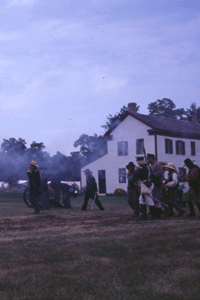at Battle of Athens State Historic Site
 A loss of life and livelihood
A loss of life and livelihood
Missouri's northernmost Civil War battle, Battle of Athens, not only was significant in keeping northeast Missouri under Union control, but had a major impact on a thriving river town.
John Boon of Kentucky was the first settler at the Athens site around 1831, and by 1841, it had a post office. By the late 1840s, a federal lock and dam had been built on the Des Moines River that converted Athens into a bustling river port. The town grew to be a village of about 500 people with 50 businesses, five churches and a two-story public school. Businesses included a large hotel, a wagon factory, a meat packing plant and a large mill that produced flour, cornmeal, lumber, and cotton and woolen products.
Athens prospered until the outbreak of the Civil War. Settled by people from the upper South, Athens was considered by Unionists to be a hotbed of pro-South sentiment. As the spring of 1861 moved into summer, northeast Missourians began choosing sides in the ever-widening national conflict.
Pro-Unionists rallied around David Moore, who had raised a force of about 500 men. Moore entered and occupied Athens on July 24, seizing homes and businesses from pro-South supporters to quarter and provision his troops. Pro-South supporters rallied around Col. Martin Green. Green raised a force of about 3,000 men, including two of Moore's sons.
The confrontation between Moore's and Green's forces took place at Athens on Aug. 5, 1861. The battle began around 5 a.m. Moore and his Unionists were surrounded on three sides by Green's troops, with the Des Moines River to their rear. Despite being outnumbered at least five to one, Moore's men were better trained and equipped. After about two hours of fighting, at least 50 soldiers had been wounded or killed and the pro-South side was demoralized and in full retreat.
The big loser in the battle was the town of Athens. Bitter feelings between neighbors continued for decades following the Civil War. Athens was also hurt by the shift from river to railroad transportation in the post-war era. By 1900, the once-thriving town was nearly gone.
Commemorations of the Battle of Athens were first held in 1868 and became annual events in 1900. In 1962, area residents interested in preserving the battle site formed the Athens Park Development Association. They held annual events including dances, raffles and a motorcycle hill climb to raise money to finance land purchases. Through land donations, purchases and hard work, the group was able to create Battle of Athens Park. In 1975, the group donated the park to the Missouri State Park Board and Battle of Athens State Park was born. In 1981, the site began hosting Civil War battle reenactments and in 1985, the facility was reclassified as a state historic site.
Archaeological research conducted since the park was established has uncovered evidence that a long Native American occupation of the area preceded the historic town site and included an early 19th century Sauk and Fox village.
Today, the historic site encompasses much of the former town of Athens. Several buildings have been preserved and are undergoing restoration. Foremost is the Thome-Benning house, locally known as "the Cannonball House," which still exhibits two holes made through the kitchen walls by a cannonball during the battle. Visitors can tour the house, visit the Thome mill ruins, participate in guided tours of the historic town site or take advantage of numerous recreation opportunities. There are hiking trails, a lake for fishing and boating, picnic areas, a playground, a campground, and 1.5 miles of Des Moines River frontage. The facility also contains the Des Moines River Ravines Natural Area, home of numerous rare ferns, wildflowers and other plants.






